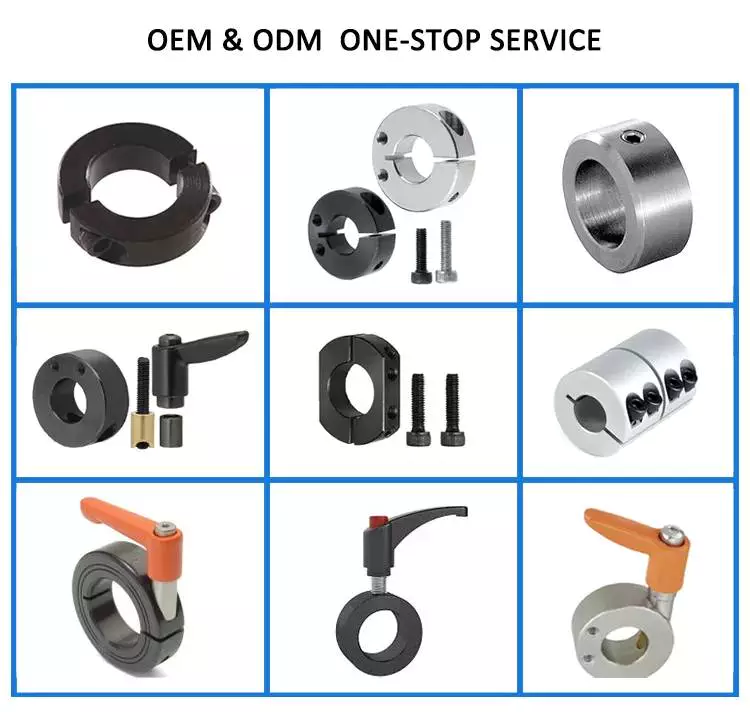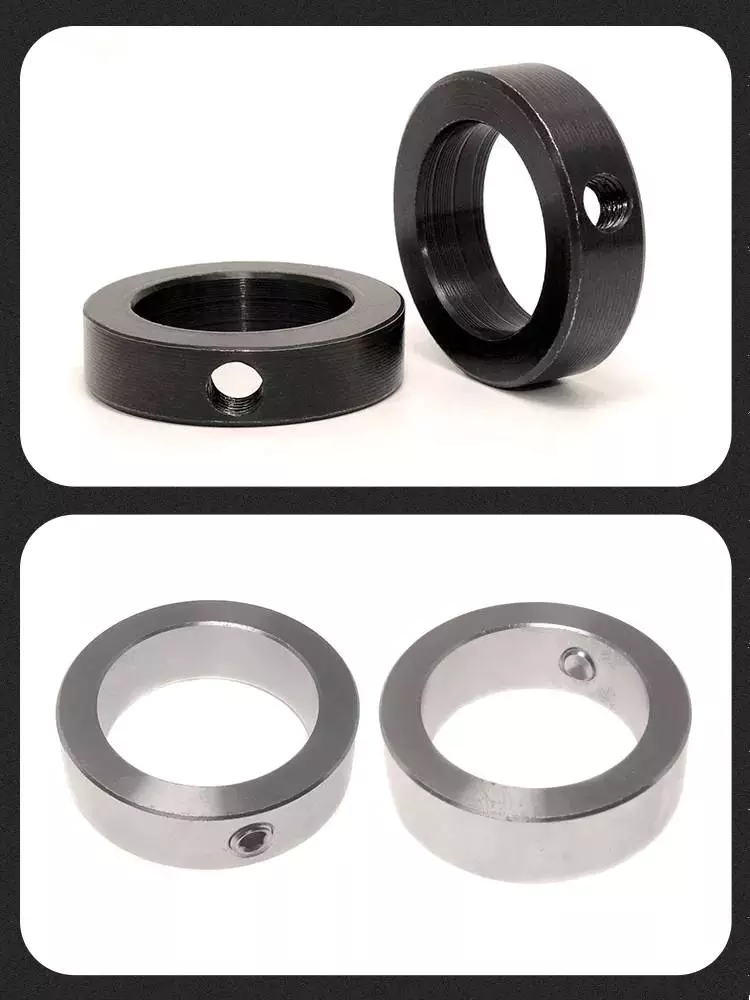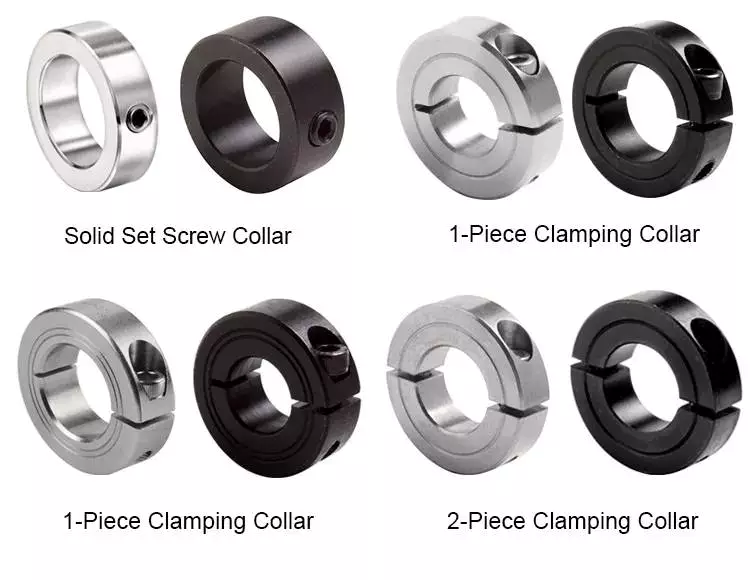
Are there guidelines on selecting shaft collars for applications with varying loads?
Yes, there are guidelines available to help in selecting shaft collars for applications with varying loads. When choosing shaft collars, it is important to consider the expected load conditions to ensure proper performance and prevent failures. Here are some guidelines to consider:
- Load Capacity Ratings: Shaft collars are typically assigned load capacity ratings by manufacturers. These ratings indicate the maximum load that a collar can withstand without deformation or failure. When selecting shaft collars for applications with varying loads, it is important to choose collars with load capacity ratings that exceed the maximum expected load in the application. This provides a safety margin and ensures reliable performance even under fluctuating load conditions.
- Dynamic Load Considerations: In applications with varying loads, it is important to consider both the static and dynamic load conditions. Static load refers to the constant load applied to the shaft collar, while dynamic load refers to the fluctuating or cyclic loads. The dynamic load can be higher than the static load due to factors such as vibrations, impacts, or operational variations. Ensure that the selected shaft collars have sufficient dynamic load capacity to handle the varying loads without premature failure.
- Material Strength: The material strength of the shaft collar is a critical factor in load-bearing capacity. Different materials, such as steel, stainless steel, aluminum, or plastic, have varying strength properties. For applications with varying loads, consider selecting shaft collars made from materials with higher strength and fatigue resistance to ensure they can withstand the load fluctuations without experiencing permanent deformation or fatigue failure.
- Design Features: Certain design features of shaft collars can enhance their load-bearing capacity and performance. For example, collars with a wider width or thicker cross-section can provide greater strength and resistance against deformation. Additionally, collars with multiple set screws or clamping mechanisms can distribute the load more evenly and provide a secure grip on the shaft, reducing the risk of slippage or misalignment under varying loads.
- Consulting with Manufacturers or Engineers: If you have specific application requirements or complex load conditions, it is advisable to consult with shaft collar manufacturers or mechanical engineers. They can provide expert guidance and recommend suitable collar designs, materials, and sizes based on the specific load variations in your application. Manufacturers often have engineering support teams that can assist in selecting the appropriate shaft collars for varying load conditions.
Remember that the selection of shaft collars for applications with varying loads should be based on a thorough understanding of the load characteristics, anticipated load range, and the specific requirements of the application. It is essential to choose collars that can safely and reliably handle the maximum expected loads to ensure optimal performance and prevent premature failure.

What are the advantages of using two-piece vs. one-piece shaft collars?
When considering shaft collars, you may come across two main types: two-piece and one-piece shaft collars. Each type has its advantages depending on the specific application and requirements. Here are the advantages of using two-piece and one-piece shaft collars:
Advantages of Two-Piece Shaft Collars:
- Easy Installation and Removal: Two-piece shaft collars are designed to be split into two halves, allowing for easy installation or removal on a shaft without the need to disassemble other components or move the shaft. This can save time and effort during installation or maintenance procedures.
- Positioning Flexibility: Two-piece collars often have a clamping mechanism that allows for fine adjustment and precise positioning along the shaft. This can be advantageous when precise placement is required, such as aligning components or achieving specific clearance or spacing.
- Accessibility for Retrofitting: In situations where it may be difficult or impractical to slide a collar onto the end of a shaft, two-piece collars provide a convenient retrofitting solution. They can be installed around the shaft by opening the collar and clamping it in place, making them suitable for retrofitting on existing shafts or equipment without requiring shaft disassembly.
- Shaft Protection: Two-piece collars typically have a split design with smooth, rounded edges, which helps prevent damage to the shaft during installation or removal. The collar halves can distribute clamping forces evenly, reducing the risk of shaft deformation or scoring.
- Collar Customization: Two-piece collars often offer more customization options, such as the ability to replace or interchange collar components, add features like mounting holes or attachment points, or modify the collar to accommodate specific shaft sizes or configurations.
Advantages of One-Piece Shaft Collars:
- Simplicity and Compactness: One-piece shaft collars have a simple, solid construction without any moving parts or additional components. This makes them compact and easy to handle, and they require less space along the shaft compared to two-piece collars.
- Cost-Effectiveness: One-piece collars are often more cost-effective than two-piece collars due to their simpler design and manufacturing process. They can be a budget-friendly option for applications where precise positioning or frequent adjustments are not required.
- High Clamping Force: One-piece collars can provide high clamping force due to their solid construction and uniform distribution of pressure. This makes them suitable for applications where a secure and rigid connection between the collar and the shaft is crucial.
- Low Maintenance: Since one-piece collars do not have moving or adjustable parts, they typically require less maintenance. Once installed, they provide a reliable and stable connection without the need for periodic adjustments or repositioning.
- Compatibility with High-Speed Applications: One-piece collars are generally well-suited for high-speed applications due to their solid construction and balanced design, which can minimize the risk of imbalance or vibration at high rotational speeds.
Ultimately, the choice between two-piece and one-piece shaft collars depends on factors such as the specific application requirements, ease of installation or retrofitting, customization needs, cost considerations, and desired level of adjustability or precision. It is important to evaluate these factors and select the type of shaft collar that best suits your needs for optimal performance and functionality.

What is a shaft collar and its role in mechanical systems?
A shaft collar is a mechanical component used in various applications to provide support, positioning, and locking functions for rotating shafts. It is a cylindrical device that fits around a shaft and is typically secured in place using set screws or clamping mechanisms. The collar is designed to prevent axial movement of the shaft and maintain its position within a mechanical system. Here is a detailed explanation of the role and significance of shaft collars in mechanical systems:
Support and Positioning:
One of the primary roles of a shaft collar is to provide support and positioning for a shaft within a mechanical system. It acts as a physical barrier that prevents the shaft from moving along its axial direction. By securing the collar at a specific location along the shaft, it helps maintain the desired position of the shaft relative to other components, such as bearings, gears, or pulleys. This support and positioning function ensures proper alignment and operation of the system, preventing unwanted vibrations, misalignment, or excessive wear.
Axial Load Distribution:
Shaft collars also help distribute axial loads along the length of the shaft. When a mechanical system experiences axial forces or thrust, the collar can help transmit and distribute these forces to the supporting components, such as bearings or thrust washers. By evenly distributing the load, shaft collars help prevent localized stress concentrations and improve the overall load-bearing capacity of the system.
Limiting Radial Movement:
In addition to preventing axial movement, shaft collars can also limit radial movement of the shaft within a given range. The collar's design and tight fit around the shaft create a mechanical barrier that restricts radial play or shifting of the shaft. This is particularly important in applications where precise positioning or clearance control is required, such as in linear motion systems, conveyor systems, or machinery with rotating components.
Securing Components:
Shaft collars often serve as a means of securing other components onto the shaft. They can act as a stopping point or reference surface against which other elements, such as bearings, sprockets, gears, or pulleys, can be mounted. By securing these components with set screws or clamping mechanisms, shaft collars ensure their proper alignment and prevent unintentional movement or disengagement during operation.
Adjustability and Easy Installation:
Another advantage of shaft collars is their adjustability and ease of installation. They can be easily positioned and moved along the shaft without requiring complex tools or specialized equipment. This adjustability allows for fine-tuning of the shaft's position and alignment within the system. Additionally, the simplicity of their design and installation makes shaft collars a cost-effective solution for various mechanical applications.
Overall, shaft collars play a significant role in mechanical systems by providing support, positioning, load distribution, and component securing functions. Their presence helps ensure the stability, alignment, and efficient operation of rotating shafts in diverse applications across industries such as manufacturing, automation, robotics, and machinery.


editor by CX 2024-01-23